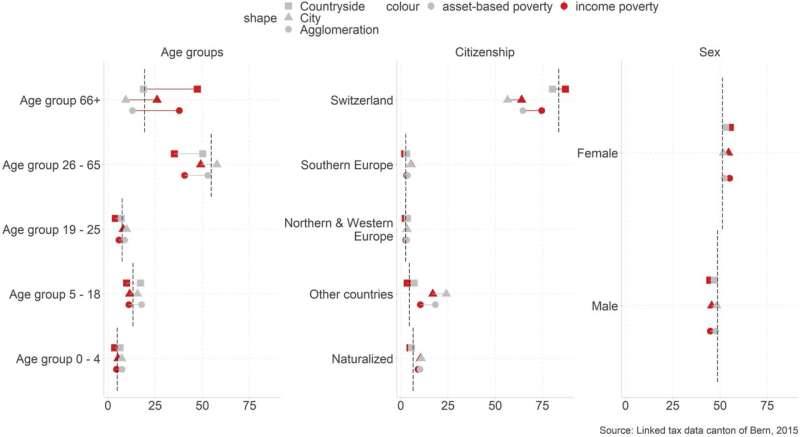Social structure by social groups. Note. The figure shows the composition of the poor by age group, nationality, and gender for the poor living in urban, metropolitan, and rural areas. The dashed line shows the composition of the total population. Credit: Local Economy: The Journal of the Local Economy Policy Unit (2022). DOI: 10.1177/02690942221104774
According to a study from the World Bank, global poverty is unequally distributed among urban and rural areas: four out of five people with income below the poverty line live in rural regions. Previously, it was unclear whether this pattern also holds for affluent countries like Switzerland. Now, a study carried out at the Bern University of Applied Sciences shows that in Switzerland, poverty is almost equally distributed between urban and rural areas. However, various social groups, depending on where they live, have too little money.
"Until a few years ago, the main problem with poverty analysis was that it was not possible to connect the numerous existing data," says social scientist Oliver Hümbelin of the Bern University of Applied Sciences. A study he conducted has now succeeded in doing so, while respecting data protection. Hümbelin's analysis included the complete tax data of the Canton of Bern from 2015 as well as other administrative data and survey results. This approach enabled a granular breakdown of the information based on social factors such as education, family situation, occupation and origin.
No great inequality in Switzerland
The study showed that the overall proportion of poor people in cities (7%) is actually slightly higher than in the countryside (5%). "We don't find great inequality in Switzerland, unlike in the U.S. or in developing countries, where the countryside is completely left behind," says Hümbelin. Specific groups such as women, single parents and people with little education are disproportionately affected by poverty, regardless of whether it is urban or rural. For other groups, the researchers found clear regional differences. In the cities, it is mainly people from certain occupational groups who are poor (freelancers and service providers such as domestic helpers) as well as people from migrant countries outside Europe. In the countryside, in contrast, people who work in agriculture and retired people in particular fall below the cut-off for receiving social assistance.
Further analyses have shown that the financial situation also depends strongly on phase of life. Families with small children, for example, often subsist just above the poverty line. The situation improves when the youngest child enters kindergarten. And when the children reach adulthood, wealth equalizes with that of the general population.
According to Hümbelin, these findings suggest avenues for developing appropriate poverty policies in Switzerland. Such efforts would be supported by national poverty monitoring, for which the Federal Council is currently developing a concept. Among other things, the aim is to identify risk groups. The Bern University of Applied Sciences also supports cantons in implementing canton-specific poverty monitoring. "Poverty policy is largely the responsibility of the cantons, but it is precisely at this level that we still don't know very much," says Hümbelin. "To be able to proceed in a knowledge-based way, you have to make use of the data."
The study appears in the journal Local Economy: The Journal of the Local Economy Policy Unit.
More information: Oliver Hümbelin et al, Rich cities, poor countryside? Social structure of the poor and poverty risks in urban and rural places in an affluent country, Local Economy: The Journal of the Local Economy Policy Unit (2022). DOI: 10.1177/02690942221104774
Provided by Swiss National Science Foundation























